Yves here. As we suggested, the sparring over the size of two Biden bills, “infrastructure” and “Build Back Better” has, perhaps conveniently, diverted attention from what is in these boxes. Despite the fact that the infrastructure bill has more support, because smaller and presumed quick tangible results across the US, there’s a lot not to like. First, if you actually wanted to fix things, the infrastructure bill consists of only $550 billion in new spending. Second, the infrastructure bill contains goodies that will extend the sell-by date of carbon producers. While it’s impossible to come up with a precise calculation, it appears that the clean green energy components of the “Build Back Better” scheme are considerably if not fully offset by the sops to dirty energy. No wonder Manchin is keen about the infrastructure bill while throwing sand in the gears of “Build Back Better”.
By Julie Dermansky, a multimedia reporter and artist based in New Orleans. She is an affiliate scholar at Rutgers University’s Center for the Study of Genocide and Human Rights. Visit her website at www.jsdart.com. Originally published at DeSmog Blog
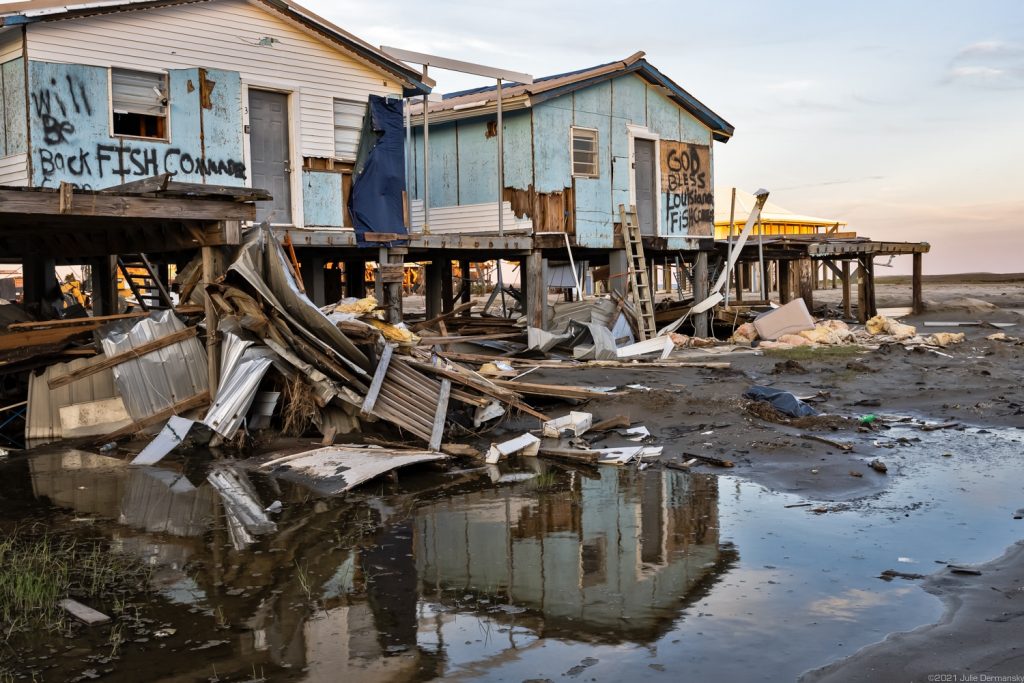
“Blah, blah, blah … Build back better. Blah, blah, blah …” Greta Thunberg, the Swedish climate activist, said this week, taking a jab at President Biden’s signature legislative agenda, which is currently imperiled by disagreements within his own party. The pair of bills — a $1 trillion infrastructure package that passed the Senate with bipartisan support and the $3.5 trillion Build Back Better Act filled with social and climate program expansions — purports to take on climate change, but Thunberg dismissed the legislation in her comments during the opening session of the Youth4Climate event in Milan, Italy, on September 28. She added, “This is all we hear from our so-called leaders: Net zero by 2025. By 2050! Words that sound great, but so far have led to no action.”
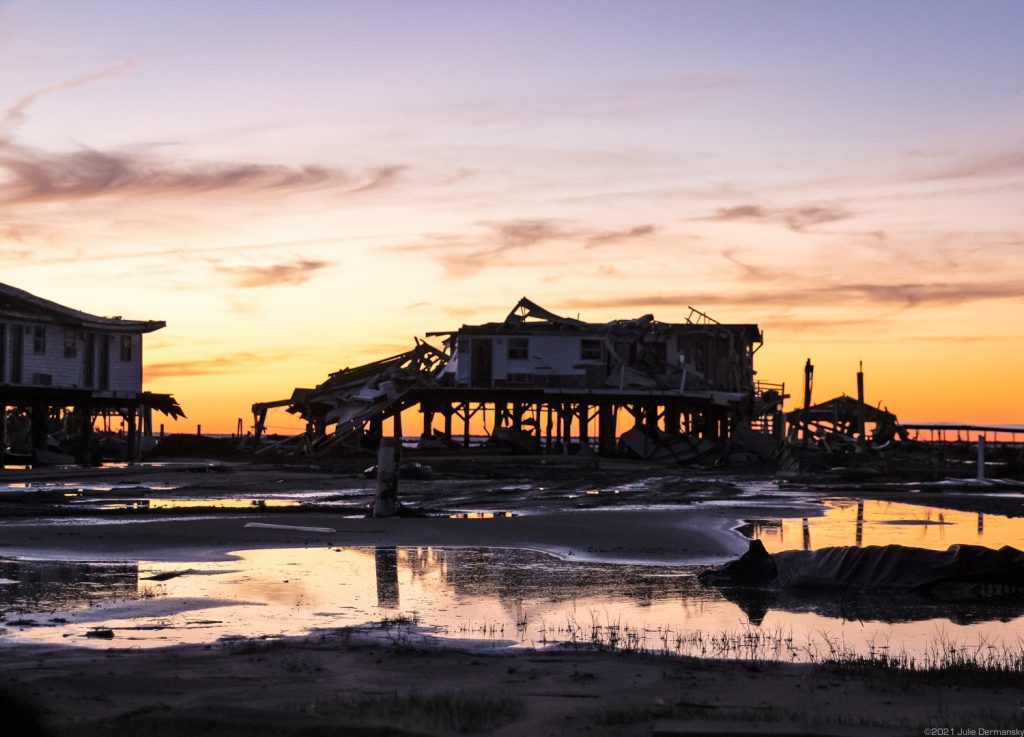
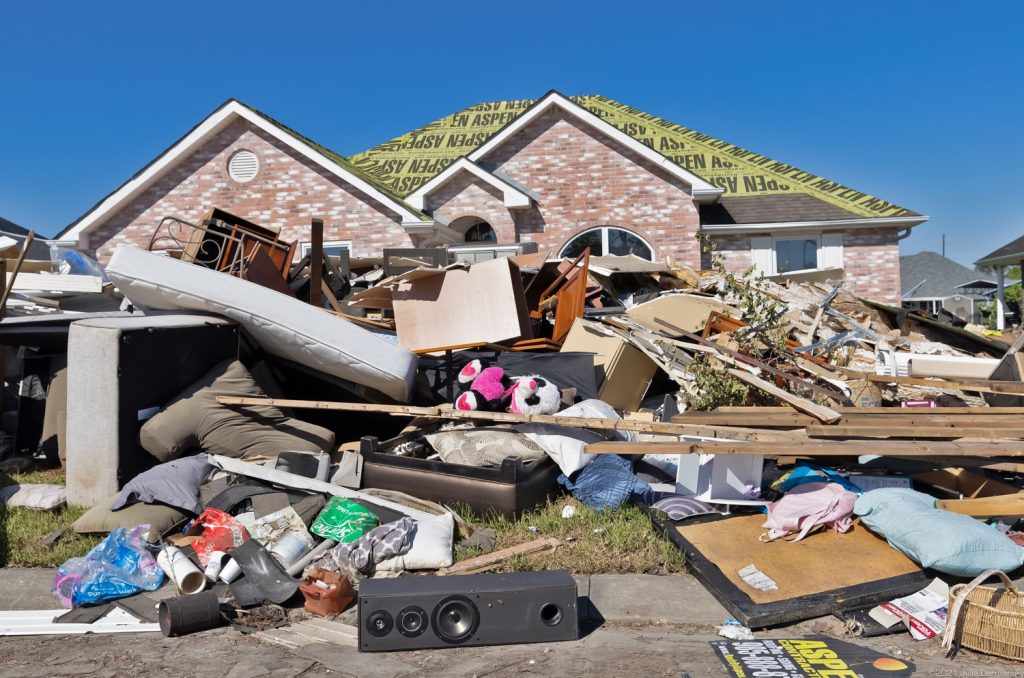
In hurricane-ravaged Louisiana, Traditional Chief Shirell Parfait-Dardar of the Grand Caillou/Dulac Band of Biloxi-Chitimacha-Choctaw Tribe can relate to Thunberg’s words. She has not heard a single word from any politicians about what “building back better” looks like in practice since Hurricane Ida destroyed her home and the homes of thousands of others in south Louisiana just over a month ago. And she is painfully aware of projections from the United Nations that carbon emissions are on track to blow past Paris Agreement goals by 2030, with even more devastating consequences to come from the additional global heating.
In early September, I photographed Parfait-Dardar in her destroyed home in Chauvin, Louisiana, about 70 miles southwest of New Orleans, where her family is facing the impacts of the climate crisis in real time. Later that month, she told me that she sees the continued destruction of coastal communities as a reminder that leaders have done little to protect us from the catastrophic impacts of global warming despite decades of warnings from climate scientists.
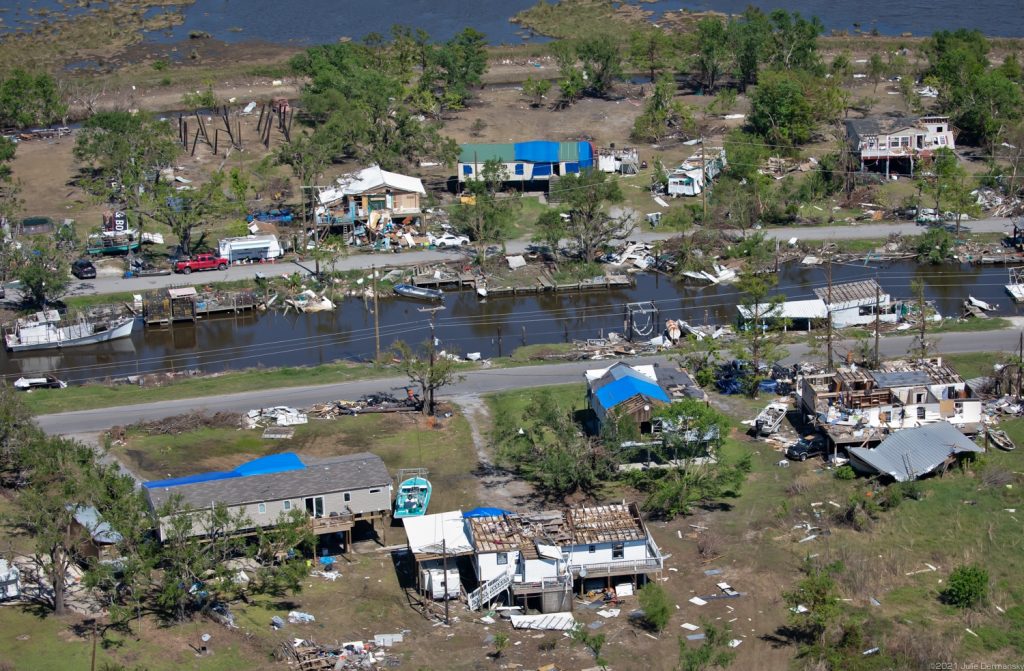
While she is honored to be an appointed member of the Louisiana Climate Initiative Task Force, which Gov. John Bel Edwards established in August 2020, Parfait-Dardar’s service doesn’t give her any special power to help those suffering around her, some of whom are still without power and water. Temporary housing for her and her community has yet to be supplied by FEMA.
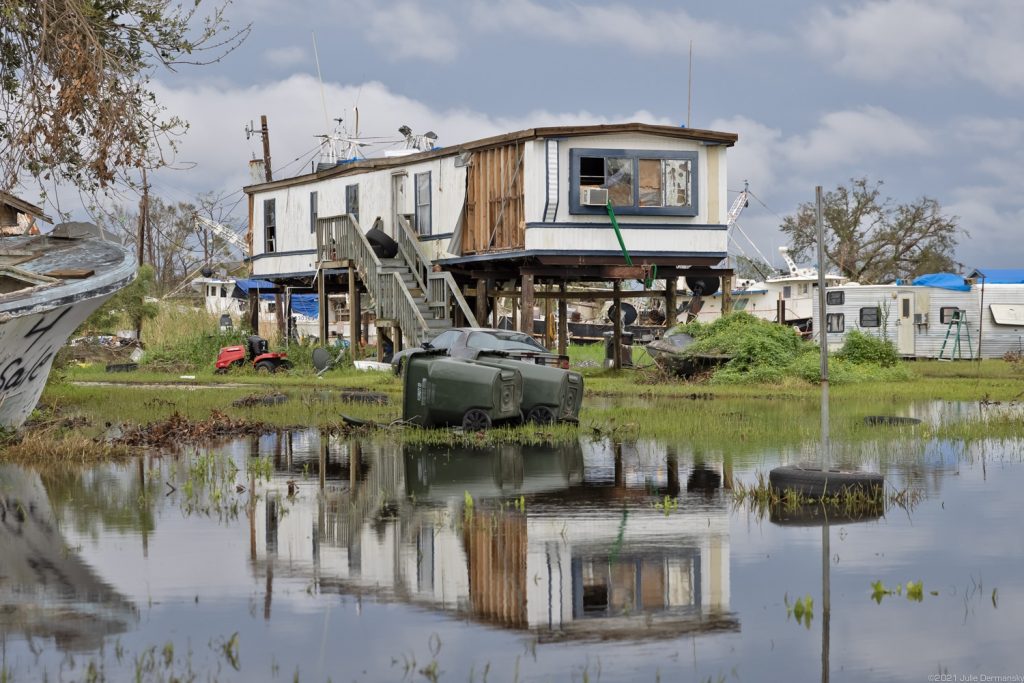
At a special climate task force meeting held on September 29, Chief Parfait-Dardar warned that the destruction caused by Ida “is a perfect example of what is going to continue to happen if we do not listen to the science and the wisdom of traditional ecological knowledge in respecting our environment and planet.” While she sees value in her work on the task force, she told me that her plans to build back better are not reliant on any government. I have been documenting the impacts of Hurricane Ida in Louisiana for DeSmog since the storm hit the state’s coast as a Category 4 storm on August 29. While funding to rebuild after extreme weather events like Hurricane Ida is not part of the current infrastructure packages, my photographs capture the magnitude of the climate crisis’s impacts on the country’s existing infrastructure.
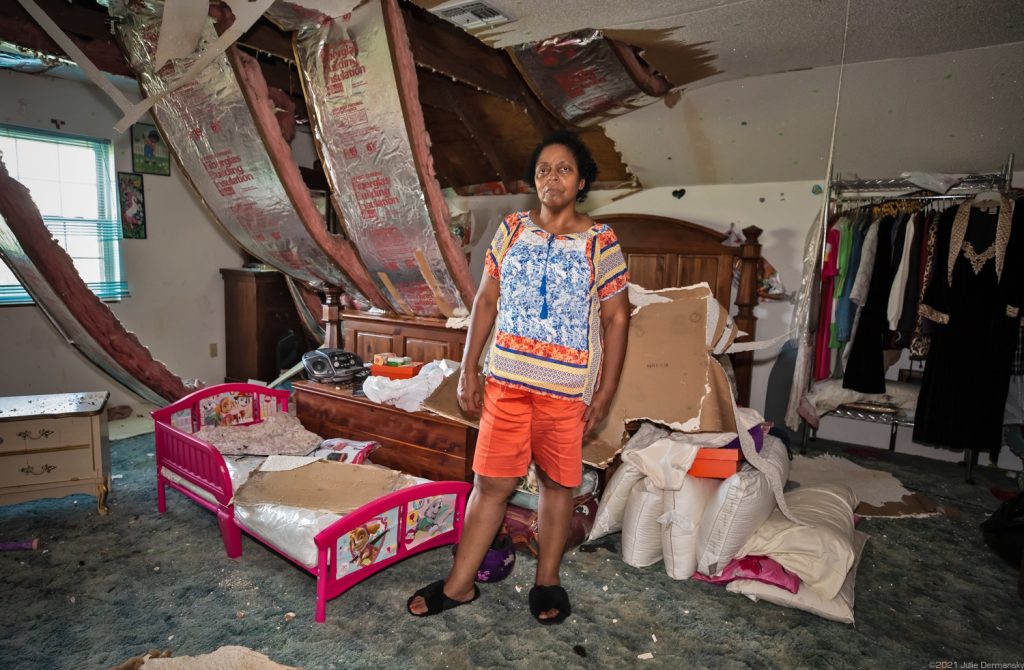
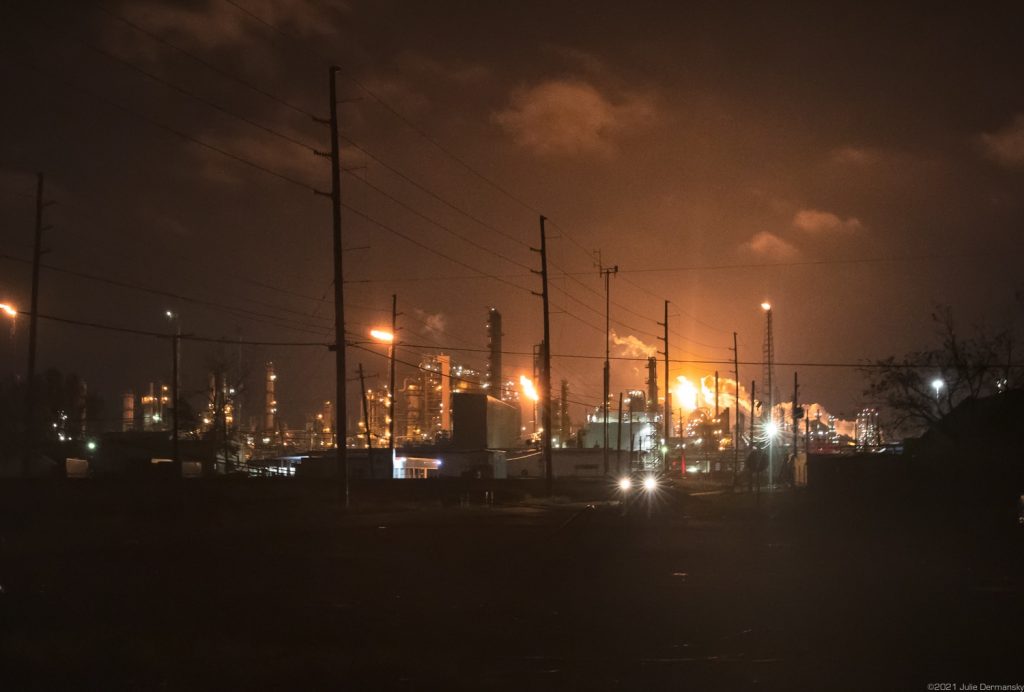
“The key word in climate action plan isn’t ‘plan’ but it is ‘action,’” said Harry Vorhoff, deputy director of the Louisiana Governor’s Office of Coastal Activities, New Orleans, during the recent task force meeting. “We need action now more than ever —and I don’t think it is any more apparent than it is today and action is more achievable when more and more people are saying that that there is no other option than action.”
Where such action will come from depends on whom you ask. Many progressive American politicians support passing both the bipartisan infrastructure bill and the Build Back Better Act as a move in the right direction on climate. However, critics say that funding in both proposals will let the fossil fuel industry off the hook and allow it to create new infrastructure that is incompatible with meaningful climate action.
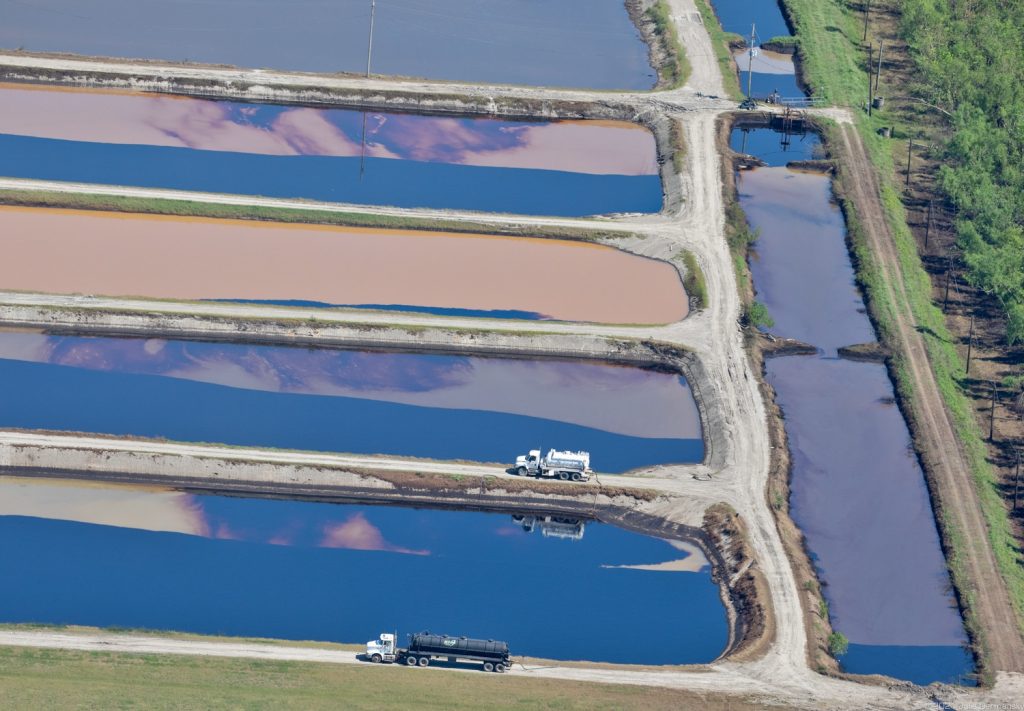
Five advocacy groups, for instance, wrote in a recent letter to Congressional Democratic leaders, “The inclusion of a carbon tax … gives a green light for the biggest climate scofflaws to pay to pollute and maintain a harmful status quo. We urge you to oppose a carbon tax and instead pursue other revenue streams to pay for critical infrastructure, such as eliminating fossil fuel subsidies.”
Climate Leadership?
“Taking action to address climate change can strengthen our communities and our economy,” Gov. Edwards said on May 7 while announcing he is joining a bipartisan group of governors in committing to uphold the provisions of the Paris Agreement.
Gov. Edwards is the type of “so-called leader” Thunberg was referring to in her speech about words but not action. On August 19, 2020, he issued an executive order on climate change, committing Louisiana to net zero greenhouse gas emissions by 2050. Those plans heavily rely on approaches backed by the fossil fuel industry, a powerful lobby in the state, which include carbon capture and hydrogen fuel made from natural gas. Critics warn both will likely add to the problem of climate change.

The Build Back Better Act and the infrastructure package do include billions of dollars in funding for climate resilience, allocating tens of billions for flood protection against wildfires and the development of new sources for drinking water in drought-stricken areas of the county, as well as funds to relocate communities in areas threatened by sea-level rise. However, critics warn the pair of bills also direct billions to the fossil fuel industry to create new infrastructure projects for carbon capture and hydrogen fuel made from natural gas, neither of which are commercially viable technologies. Instead, critics such as Pennsylvania State University climate scientist Michael Mann say such approaches give oil, gas, and coal companies a lifeline instead of incentivizing a transition to renewable energy.
“These tactics are straight out of The New Climate War that I write about: politicians using soothing promises of future technology that will magically fix the problem, as an excuse for ‘business as usual’ by carbon polluters,” Mann wrote via email. “The supposed ‘bi-partisan’ infrastructure package could potentially leave us worse off on climate through big giveaways to the fossil fuel industry in the form of subsidies — both direct and indirect — that actually increase the unfair advantage they have over clean energy producers.”
He adds, “What we really need is for congress to pass the ‘Build Back Better’ reconciliation package, which supports meaningful climate action, with the climate provisions intact.”

However, some advocacy groups including the Indigenous Environmental Network, Climate Justice Alliance, and Grassroots Global Justice Alliance have come out against both major pieces of legislation since they contend that each one includes some form of fossil fuel subsidies.
“Congress promised our communities they would work to solve the climate crisis and environmental justice once we elected them into office, but instead, we see them fighting to fund fossil fuels and false promises masquerading as climate solutions to the tune of billions of dollars,” a September 30 press release from the three groups states. “Rather than solving climate change Congress is exacerbating it.” They assert that the infrastructure bill has $25 billion slated for new fossil fuel subsidies and the Build Back Better Act includes at least $15 billion.
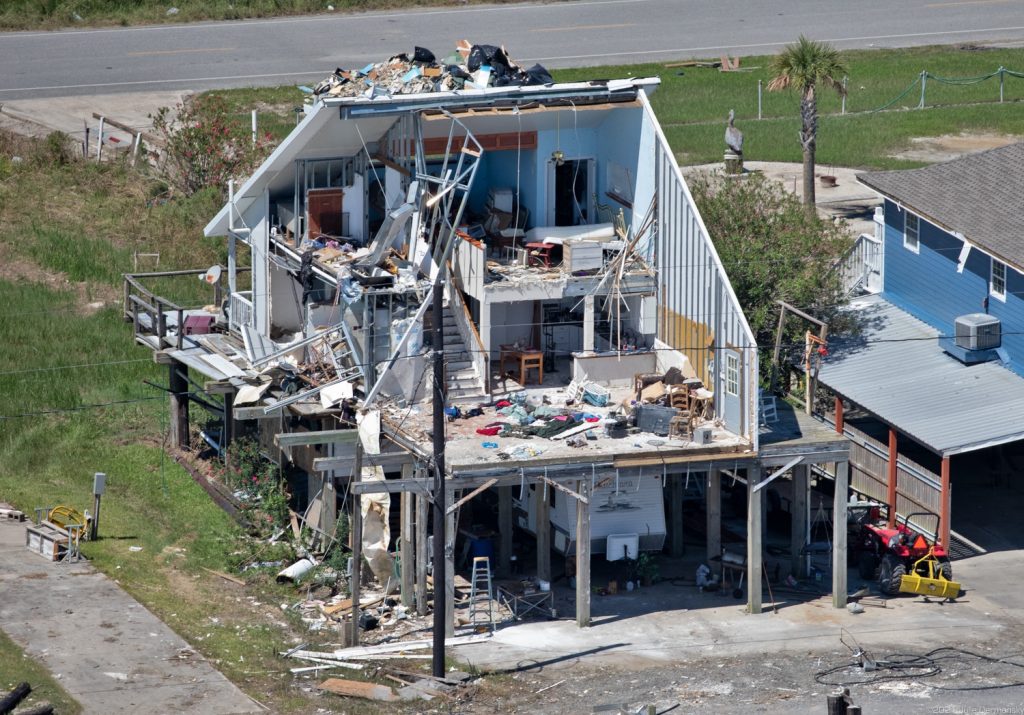
The release identifies what it labels as false climate solutions that would receive direct funding in the two bills, including the 45Q tax credit for enhanced oil recovery (the main use for storing captured carbon emissions), $1.9 billion in loan guarantees for carbon capture pipelines, liquefied natural gas (LNG), and “clean” coal programs, to name a few.
The groups claim that if the proposals pass as is, then “greedy and harmful corporations come out on top” because they say Congress has allowed “life-saving priorities” to be “watered down or completely abandoned through the process” of negotiating an agreement. “We know the true power lies with the people,” the groups state. “Rather than pretend this legislation does not perpetuate injustices to Indigenous, Black, and frontline communities and exacerbate the climate crisis, we will continue to stand with frontline struggles and uplift principles of environmental and economic justice. And we will continue to demand Congress do the same.
Thunberg used similar language in closing out her address to the youth conference: “Hope is not passive. Hope is not blah, blah, blah. Hope is telling the truth. Hope is taking action. And hope always comes from the people.”
27 comments
Comments are closed.


OK – Here is the ONLY first STEP – Immediately drop ALL subsidies (direct and indirect) subsidies to ALL forms of Fossil Fuel energy. They makes billions of dollars but STILL they need government help ( oh poor little guys ) they have had these subsidies starting in the late 1800’s. If you want too, you can drop ALL ENERGY subsidies, if you drop them all solar and wind will be 10X cheaper than Fossil fuels because of the massive difference that each get – Just direct Fossil Fuel subsidies are over $20 Billion a year and the indirect ( tax breaks, paying for their clean up, polluting the planet and killing thousands of people a year (air pollution) is surely greater than the 20 Billion for direct subsidies. To make it even more simple, obvious and mind blowing – if you tool away all fossil fuel subsidies we would be paying approximately $12.75 PER GALLON. So think of all the gallons of gasoline alone we use per multiple it times $9.75 ( the 12.75 – a average of 3.00 per gallon now ) and you will come up with a mind boggling number that the government is giving to guys who have been KILLING millions of people for decades and whose long range “PLAN” (INSANE PLAN) is to destroy the ability of Earth to support humans, all humans including THEIR families. Truly the suicidal LOVE OF MONEY beyond belief.
Peter Lynch is right. The only thing to do is stop all subsidies for fossil fuels, and put that money into conservation and alternative energies like solar, wind and geothermal. Any bill, including the omnibus measures currently under consideration, that continues fossil fuel subsidies should be voted down. We got to this point through deliberate, incessant, stonewalling. Conservatives sought to shrink and then drown public services. We need to be willing to do the same to the fossil fuel industry. This is a race for survival, it’s time everyone started acting like it.
Or put all the money into…nothing.
If we really want to get out of this mess, we’re going to need fewer people using far less energy.
To be clear, the ‘subsidies’ in question are actually very normal business operation deductions that every company paying taxes in the US takes advantage of.
$12.75 per gallon, makes the majority of Americans broke pretty fast. Granted, they are paying the money (through future federal indebtedness) in some fashion now. But the $12.75 is here and now.
And having worked in the solar pv industry (install and operation/maintenance), I can pretty well insure you that we are not remotely close to them being able to substitute in for carbon based fuels.
I am not saying we don’t have a problem. That is obvious. But your solution, based on your numbers, makes a future existential threat, an immediate existential threat.
Thanks. My point just below is that regardless of how people rack up the various tax provisions and any other incentives that the fossil fuel industry uses, the benchmark for the population is the price of gasoline or heating or electricity as it is billed to them. Sometimes I feel as if people who tell me that the “real” price of energy is some large multiple of what I pay at the pump or in my utility bill simply want me to accept that paying double for their preferred kind of energy is really paying less somehow, so I should not be concerned. But I think there is close to zero chance that the increment would be returned in a manner that my family and I can actually use.
If the petroleum industry gets subsidies that bring the price down from $12.75/gal to $3.00/gal, but then sell the product at $3.00/gal, then the subsidy is the consumer’s, not the producer’s.
Logically then, those who consume the most get most of the subsidy dollars. That makes no sense. It’s an incentive to consume more gasoline rather than less. Rewards should not be going to those who consume more gasoline, but to those who consume less.
Yes, that’s right, but people don’t spend an extra $3 in order to notionally enjoy $9.75 of subsidy that is not discretionary income. The $3 is mine and the $9.75 isn’t.
Then second step, use the billions of dollars that were being given to fossil fuel companies and send checks directly to every person who makes less than $75,000. per year.
We need to simply burn less carbon, full stop.
That means doing things like taxing business travel. No good reason to have folks jetting around to attend conferences, meetings that can be done over Zoom or Webex. If the last 18 months did not convince people of this, they need help.
And the daily commute by car needs to be addressed. Cut fossil subsidies as Peter Lynch posted above. Give companies tax credits for every worker they allow to work remotely.
It’s ironic that we got a preview into a lower carbon emission world in April-May 2020 and the world did not end. Yet we have the same lobbyists running the show in DC who put us in this place.
I was really enthusiastic when we did all slow down worldwide in early 2020 and hoped it might be a continuing trend. Unfortunately it’s still the old Upton Sinclair quote for most – “It is difficult to get a man to understand something when his salary depends upon his not understanding it.”
If we got to $12.00 per gallon fuel, we might actually see some organized protests.
Recall France and the farmers and working class Yellow Vest Protests a couple years ago.
The French are known for protest, for full national strikes.
Americans -as far as I know- have never agreed on anything, and certainly have never nationally organize and unified around any issue, other than War.
Dropping subsidies will not happen. BUT, if it did, it could get very ugly very fast.
We are in more of a going to get ugly in slow-mo….
And waiting on captured legislators and governments to do anything is delusional idiocy.
Incremental individual action is the only way we will see any headway.
8 billion human beans all pulling on the same harness in the same direction. Hey ho, Lets go!
I think the magic number for cratering the economy is a much lower $5/gallon
Many Americans organized for poverty relief during the Great Depression.
And we must address the consumption side of the equation. Americans are duped into believing that so called clean energy technologies will allow us to continue obscene levels of consumption and waste, like food waste that justifies wrongheaded price supports and destructive farming practices in the agricultural sector. We, then, export this “lifestyle” other countries. We have a bad track record of saying yes to technological fixes (e.g., large dam projects, nuclear power). Our current political system is ill equipped to rein in the rich and the influence they have on the rest of us. Tea on Martha’s Vineyard, anyone?
Sorry, but I think you have it basically backwards. The resistance is more that tens of millions in this country are not duped into believing that clean energy will be abundant and inexpensive and that lifestyles can be maintained under something like the Green New Deal. Heck, if you convinced people that it was merely an energy source substitution and that the technology and a fair system of making the new capital investments were ready, then things would move much quicker. People are not easily going to give up what they perceive to be material well-being. I think it is a two-step process (or more). First, find a mix of energy technologies that will not, by themselves, represent a negative change in energy pricing or availability. Later, continue to find ways to use energy more effectively.
We cannot continue down the path we’re on and still use the same amount of energy, whether that energy is fossil fuels or renewables. We need to use less – you can’t grow indefinitely on a finite planet.
This is not that clear, at least from a climate change viewpoint. This sounds more of an aesthetic judgement than a climate science one. Not saying that makes it illegitimate, but it is a distraction from climate necessary efforts. The next 40 to 60 years will likely concentrate on climate first.
It’s quite clear from a mathematical viewpoint. Reduction rather than replacement is necessary, otherwise at some point we’re going to have billions of windmills and solar panels and no animals or trees.
Economist meets Physicist
We simply don’t have enough power sucking data centers to mine all the digital excrement generated by the scrolling screens, which themselves are made of pieces of chip that consume vasts amount of coal generated power. That the power is generated in China and invisible to the short sighted doesn’t change a thing.
I have had supposedly intelligent people claim we need data centers and AI to figure out for us the problem of too much power consumption. The refrain is “moar with less” when it should be less. How is that mountian range of wobbly debt going to be paid now?
Add corn subsidies for biofuel. Problem is no one will get reelected.
Wash your mouth out. Corn biofuel is a very bad idea. The only biofuel that makes any sense is sugar cane grown in Brazil.
https://www.ewg.org/news-insights/news/corn-ethanol-bad-farmers-consumers-and-environment
Earlier today on CBS Mornings one of the anchors was out in Houston chatting up random folks regarding the climate crisis. One of the random folks basically said “we’re screwed”. I think he is correct. A professor who specializes in getting folks to actually talk about the climate crisis (most of us don’t) thinks that if more of us actually have conversations things will change. I admire her optimism, but I think it is misplaced. We are screwed.
The Infrastructure bill also is a huge step back for stewardship of our National Forests, upping the cut.
https://www.counterpunch.org/2021/09/28/infrastructure-and-budget-bills-contain-very-bad-logging-provisions-which-will-make-climate-change-worse%e2%80%a8/
At this point I hope it all falls apart and the left own it, communicate that nothing is better than what they were bait and switched to and learn they have power and should use it. Next open hearings on indicting monopolist price gouging Pharma CEOs.
The 11th picture down entitled “House destroyed by Hurricane Ida in Chauvan, LA…” is the most interesting part of the article. Save it to your computer then open it up and expand it to get a good view
The house is modern, two stories high and is half missing. The remaining side wall shows 16 ft long aluminum 2 x 4 studs with no fire stops. This is totally against code everywhere, never mind in hurricane-prone LA. The 16 ft aluminum studs are for inside use only, usually in office building atriums. Worse, the “Hurricane straps” shown hanging from the floor, front are makeshift- they should tie into the top of the wall. Finally, look closely at the beam for the peak- more aluminum. Now compare it to the low-profile house next door; low, gabled roof, real siding… not a speck of damage. Finally note the 4” X 4” pressure treated posts the buildings are supported on. They are 10 feet tall, properly braced, sunk into the ground and tied to the crossmembers above with metal “T” bracket with two through-bolts on the stem.
Also note the 4″ x 4″ pressere treated posts both buildings are supported on. They are put deep in the ground, angle braced and tied into the crossmembers above with steel “T” brackets (you can see the two bolts near the top of the posteds).
Is 12′ posts; crossbrace everything; build to code; build a house with a low profile; have steel1/8 ” slide-across steel shutters for each window and each door. “One little piggy built out of brick” (see the intact house pictures above with a brick facade); “One little piggy built out of straw”.
On the bill; weak and meaningless. We can do better. As the little girl with common sense said: “Blah, blah, blah…”